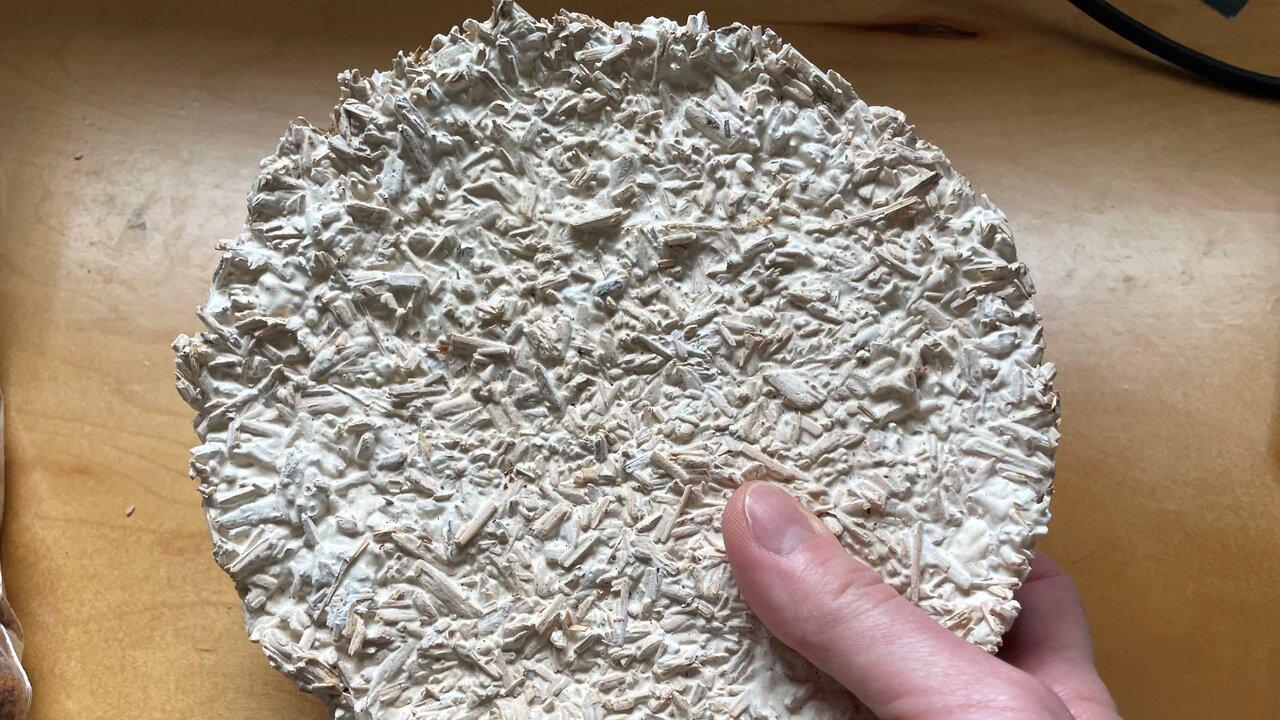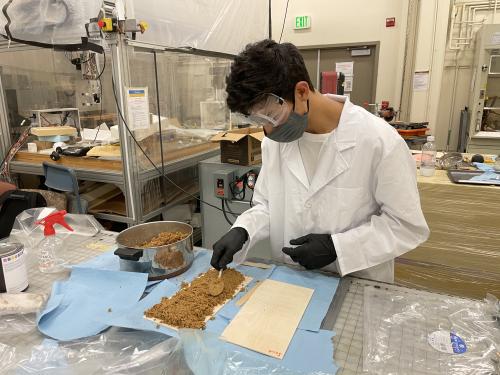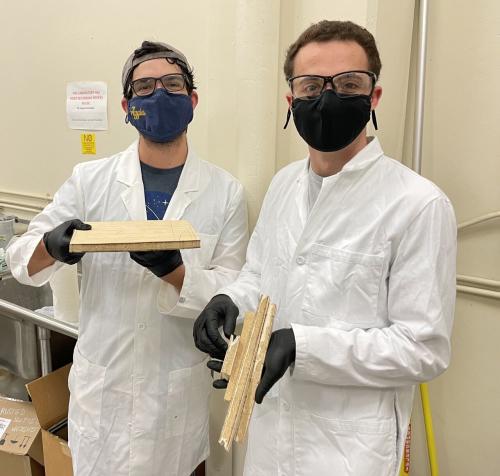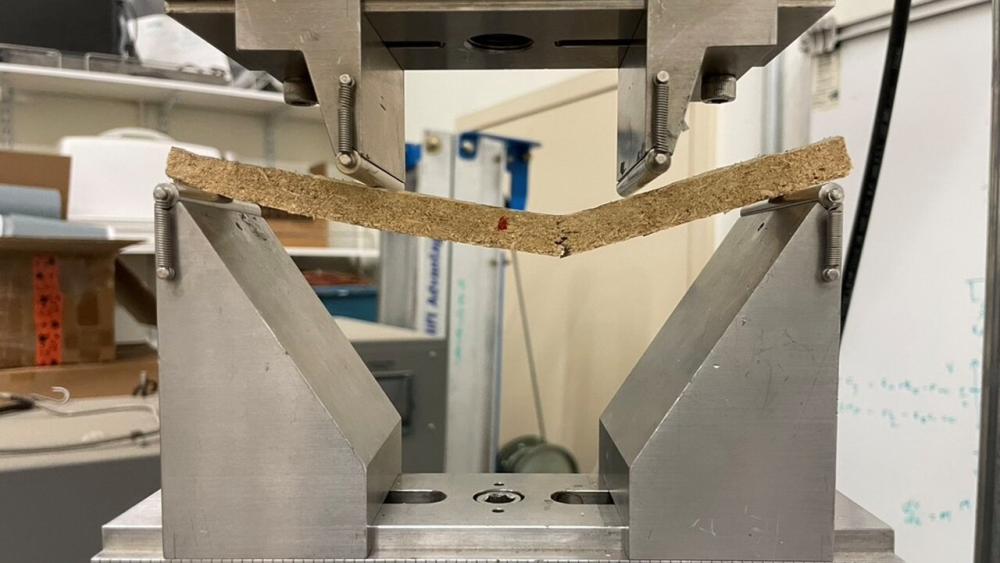
“Fungi to save the world”
How fungi roots might help build a sustainable planet
Mycelium, the white filament-like root structure of mushrooms, might be an important building block of a more sustainable world. By growing mycelium with a biomass—anything from coffee grounds to leftover agricultural waste—researchers at UC Davis are creating sustainable structures that can be turned into everything from biodegradable plastics and circuit boards to filters that remove harmful antibiotic and pesticide residues from water.
Professors Valeria La Saponara (Mechanical and Aerospace Engineering), Nitin Nitin (Biological and Agricultural Engineering and Food Science and Technology), Ameer Taha (Food Science and Technology) and Katia Vega (Design) are working together on a new project funded by the Green Initiative Fund at UC Davis to learn more about how to grow mycelium structures and what they’re capable of.
Manufacturing by Growing

Mycelium structures are heat-resistant, lightweight and hydrophobic and can be molded into different shapes as the mycelium grows. They are also compostable and help reduce agricultural waste by using biomass from local farms as the “glue.” When finished, the structures have the toughness of plastic, making it a compelling green alternative to non-degradable materials like polyurethane and acrylic.
“I want to make it better than polyurethane,” said La Saponara, an expert on composite structures. “Ideally, we want a completely low carbon emission, low toxicity process with a product that can be composted completely at the end of life.”

Each structure start with biomass and dried mycelium that requires water, nutrients, filtered air and the right temperature, humidity and light to grow. After about 6-14 days, the growing composite is transferred to a mold, where it grows in ambient conditions until the samples are baked to create the final structure. La Saponara’s group gives each sample a name like “Madeleine,” (after a student’s friend) or “Yuri,” (a riff on “polyurethane”) before testing them for their properties with tests developed for conventional composites.
Since there are millions of types of biomass and millions of types of mycelia, finding the best combination and the best growing process is key. La Saponara’s lab is experimenting with many different biomasses from farms and community gardens in the Sacramento region, and has grown samples from commercial mycelium kits, incorporating techniques developed by Vega's former design M.F.A. student Eldy Lazaro Vasquez. Optimization will allow them to grow different structures for different applications.
“I am working with commercial culture that I can grow in the biomass, but there are also [cultures] that are already in the biomass that might be the optimal type, and there are so many different types, we’re just scratching the surface,” said La Saponara.

Removing Toxic Chemicals
Mycelium is rich in biomolecules, which means it can work both a filter and a bio-catalyst to remove harmful chemicals from the environment.
“They are living systems, so they can bind with these molecules, but also they can metabolize or degrade these compounds into more benign forms,” said Nitin. “They’re both working as filters as well as metabolizing.”
Nitin and Taha have worked together before to analyze and remove hazardous chemicals from the environment: Nitin’s group performs sensing to detect the chemicals while Taha’s group validates their results. In addition, Nitin has used mycelium to encapsulate micronutrients in food, and Taha’s group has studied antibiotic residues in farmed and open water seafood, so they were a perfect fit for the project.

The two groups are looking at how well mycelium structures filter and metabolize antibiotic and pesticide residues left over from wastewater treatment or irrigation. Though the water is safe and reusable, the presence of antibiotics and pesticides “trains” pathogens to become resistant. This could devastate crops or turn a routine visit to the dentist lethal from an infection. Current technology can remove these residues, but it’s often prohibitively expensive, so the team thinks mycelium could be an alternative.
“Our ability to reduce those challenging chemicals from water streams using a more sustainable process can be a big advantage,” said Nitin. “Compared to advanced filtration or oxidation technologies, these methods are a lot more sustainable.”
Since each mycelium composite is different, some may perform better than others, and each sample might metabolize the residues into different compounds. Nitin and Taha are running bioanalysis to judge the effectiveness of the mycelia and biomass combination selected and grown in La Saponara’s lab, and make sure that the new compounds aren’t toxic or harmful in other ways. Like with the other side of the project, understanding which mycelium/biomass combinations work best is the key to moving this technology forward.
Creating a “Fung-topia”
The team is starting small, but the potential seems endless. La Saponara wants to eventually explore building compostable mycelium-based blades for wind turbines, which are currently landfilled.
The future is already here in Vega’s lab, as Lazaro Vasquez found that the mycelium can embed and enclose electronics, and she built a variety of bio-degradable electronic devices including lamps, a light-up necklace and a working circuit board. As the team continues their research and refines the designs, the opportunities can only grow.
“The main idea is that the fungi will save the world!’” said La Saponara. “Mycelium structures are showing up in a lot of different [scholarly] articles, and I just happened to be at the right time with the right community to contribute.”
